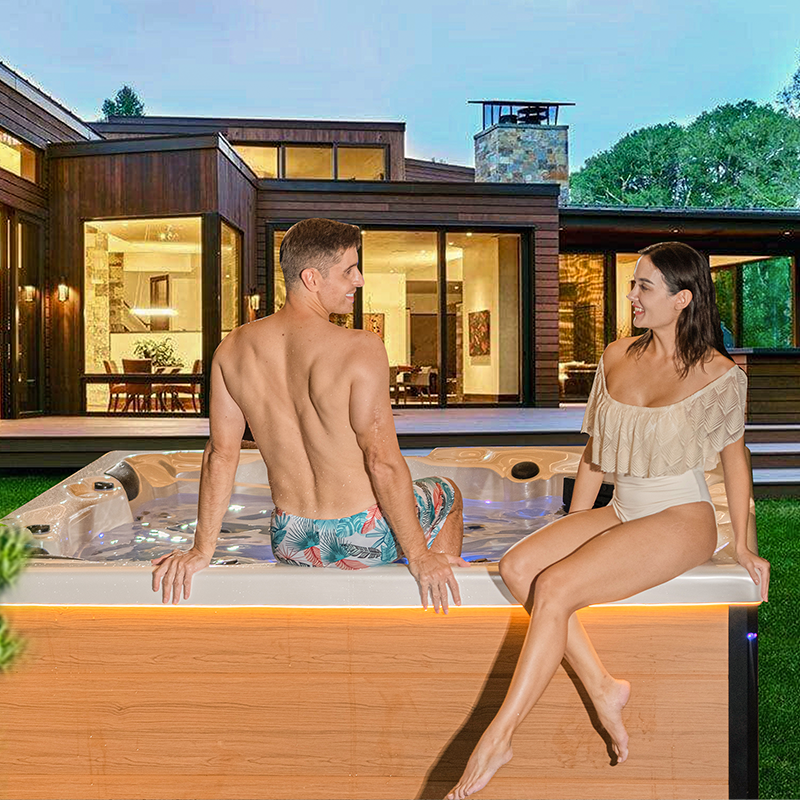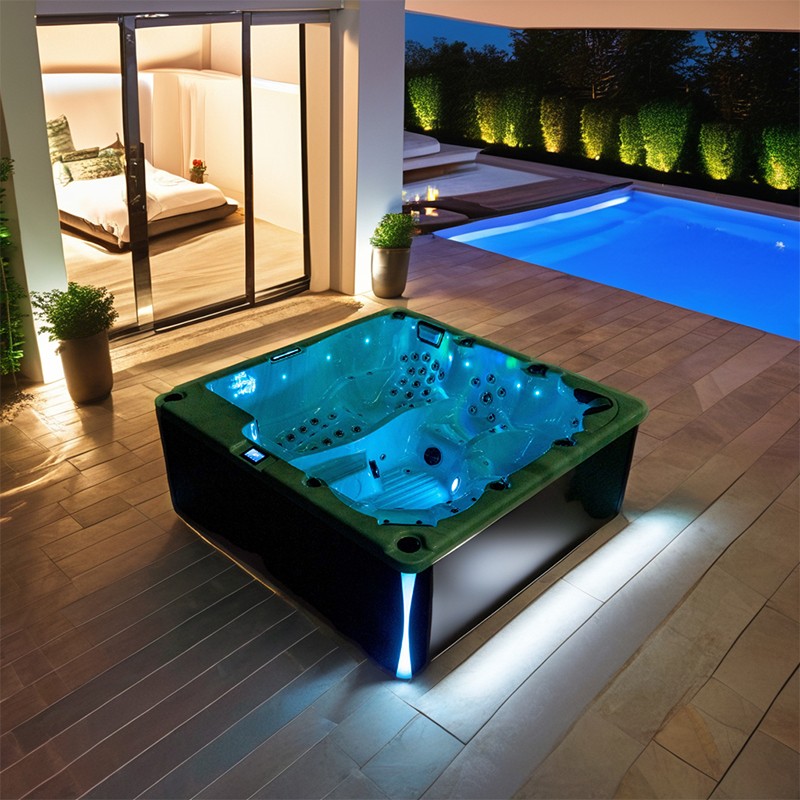
How can I reduce the cost of running my hot tub?
2025-01-02 15:35Owning a hot tub is undoubtedly a luxury, but the running costs that come with it can be prohibitive. Whether it’s electricity, water or maintenance costs, it can have an impact on the household budget. However, by taking some effective steps, you can significantly reduce the cost of running your hot bathtub.
This article will take a closer look at the factors that influence the cost of running a hot bathtub and provide practical advice on how to reduce your expenses while still enjoying the comfort and relaxation that a hot tub brings.

What factors affect the cost of running a hot tub?
There are many factors that affect the cost of running a hot tub, from how often and how long it is used, to the specifications and performance of the unit itself, and every detail can have an impact on the total cost. Understanding these factors and taking targeted measures can effectively reduce overall expenses.
● Frequency and duration of use: Frequent and prolonged use can significantly increase your electricity and water bills.
● Size of the hot tub: Larger hot bathtubs require more water and electricity to maintain temperature.
● Water temperature setting: Higher water temperatures require more energy to maintain.
● Equipment quality: High-quality equipment is usually more energy-efficient, but the initial investment is higher.
● Age of the hot water tub: Older units are generally less efficient and more expensive to maintain.
● Insulation: Good insulation can significantly reduce heat loss.
● Energy efficiency standards: Equipment that meets or exceeds energy efficiency standards is generally more efficient.
● Smart technology applications: Smart technology can help monitor and manage usage more effectively, thereby saving energy.
How often do you use your hot tub? How long to use the hot tub?
Frequency and duration of use is an important factor in the cost of running a hot tub. Frequent use means more heating and more water treatment, which directly leads to increased electricity and water bills. The Cleveland Clinic reports that even with a brief soak in a hot bathtub, you can experience a variety of health benefits, such as reduced muscle soreness, improved heart health, stress relief, lower blood pressure, and better sleep. Additionally, in an article on her clinic's website, integrative medicine physician Irina Todorov, MD, notes that you don't need to stay in the hot water for more than 15 minutes to reap these benefits.
● Control the frequency of use: Try to reduce unnecessary use, and control it to 2-3 times a week to meet relaxation needs.
● Arrange usage time reasonably: choose to use it during periods when electricity rates are lower, such as at night and on weekends, and take advantage of peak and valley electricity price policies to save money.
● Set time limit: Each use is controlled within 20 minutes, which can effectively reduce energy consumption.
● Take reasonable breaks: Arrange breaks during long periods of use to allow the water temperature to drop naturally. Just heat it up slightly before using it again to save energy.
Hot Tub Size
The size of your hot water tub directly affects the cost of running it. Larger hot tubs require more water and electricity to heat and maintain temperature. Choose the size of your hot tub based on your family's actual needs, and don't go for an oversized model just for the sake of luxury. Minimize water usage without compromising comfort. For example, the amount of water to be heated and handled can be reduced by controlling the water level. Some modern hot tub designs have zoned heating, which heats only the areas that are in use, saving energy.
Hot Tub Water Temperature
The water temperature setting is a key factor in how much it costs to run your hot water tub. Higher water temperatures require more electrical energy to maintain, and the greater the temperature difference, the faster the heat is lost. If you want to save money and conserve energy, Connexus Energy in Minnesota recommends setting your hot bathtub thermostat between 100 degrees Fahrenheit and 102 degrees Fahrenheit, as recommended by the U.S. Consumer Product Safety Commission. You might not be able to notice a one or two degree drop in water temperature, but you might be happy to notice a reduction in your electric bill.
Quality of Hot Tub Materials
The quality of your hot tub’s materials directly affects its thermal insulation and durability. High-quality materials generally retain heat better, reducing heat loss and thus lowering heating costs. Giving priority to materials with good thermal insulation properties, such as high-density foam and multi-layer structures, can significantly improve the thermal insulation effect. If your existing hot tub is made of poor quality materials, you may want to consider upgrading or replacing the insulation to improve overall efficiency.
The Age of Hot Tubs
The age of your hot tub is also a big factor in how much it will cost to run. Older equipment is often less efficient, more expensive to maintain, and more prone to breakdowns. According to HomeServe, "Older hot bathtubs tend to be less energy efficient and typically have to work harder to heat the water, thus requiring more electricity to raise the water temperature into the optimal zone. When it’s time to upgrade an older hot tub, , consider the energy-saving aspects of new models.
● Regular inspections: Perform regular inspections on older hot water tubs to ensure that all components are functioning properly and to avoid energy waste due to aging equipment.
● Gradually upgrade: If your budget allows, consider gradually replacing older equipment with new energy-efficient hot tubs to reduce long-term operating costs.
● Repair and Maintenance: Perform necessary repairs and maintenance in a timely manner to extend the life of the equipment while keeping it in optimal operating condition.

Do you use a hot tub cover, and what is the quality of that cover?
HomeServe also points out the importance of using a well-insulated hot tub cover and making sure it fits snugly around the rim of the tub. Like insulation, a hot tub cover is essential to retaining the heat of your water longer. In addition to a quality cover, HomeServe recommends: "Keep the cover in good condition. Most heat loss occurs through the spa cover. Replace the cover if the internal foam is cracked or saturated.
● Use a high-quality cover: Choose a thick, well-sealed hot tub cover to ensure it can effectively retain heat.
● Check the lid regularly: Check the condition of the lid regularly to ensure that there is no damage or leakage, and replace or repair it if necessary.
● Use the lid correctly: After each use of the hot tub, close the lid promptly to prevent heat loss and debris from entering.
Does your hot tub meet or exceed energy efficiency standards?
Hot tubs that meet or exceed energy conservation standards are generally more energy efficient and can significantly reduce operating costs.
● Choose an energy-efficient model: When purchasing a hot water tub, give priority to models that meet or exceed energy-efficiency standards, which require a slightly higher initial investment but lower long-term operating costs.
● Understand the energy efficiency rating: Understand the energy efficiency rating of the hot tub and choose a product with a higher energy efficiency rating to ensure that it can save more energy during operation.
● Pay attention to technological advances: Pay attention to technological advances in the hot tub industry, keep abreast of and adopt new energy-saving technologies and products, and improve overall energy efficiency.

Apply smart technology to help monitor and manage usage to save energy
The application of smart technology can help monitor and manage hot bathtub usage more efficiently, thereby saving energy.
● Intelligent temperature control system: Installing an intelligent temperature control system can automatically adjust the water temperature according to usage and avoid unnecessary energy waste.
● Remote Monitoring: Remotely monitor the status and usage of your hot tub via your phone or computer, and adjust settings in a timely manner to improve energy efficiency.
● Automatic timer: Use the automatic timer to set the running time of the hot bathtub to avoid long periods of idling and save electricity.
● Intelligent analysis: Use the intelligent analysis system to record and analyze usage, provide energy-saving suggestions, and help optimize usage habits and equipment operation.
By following these tips, you can significantly reduce the cost of running your hot water tub. While you enjoy the comfort and relaxation that your hot bathtub brings, taking some simple but effective measures can help you save energy and money, extend the life of the equipment, and improve your overall experience. I hope the suggestions in this article can provide you with valuable references and make your hot water tub use more economical and efficient.
With a focus on innovation and market trends, Lovia Spa continues to lead the outdoor wellness industry. Our collection includes luxurious hot tubs, swim spas, and sustainable heat pumps designed to meet the demands of hotels, wellness centers, and residential clients. Backed by With advanced manufacturing capabilities, we deliver customized OEM/ODM solutions with low wholesale prices and fast delivery.
